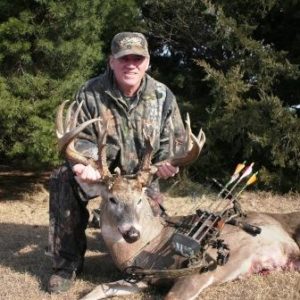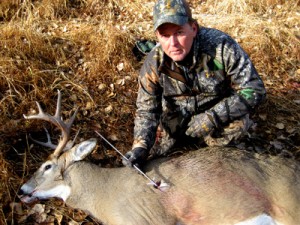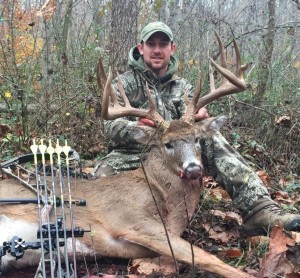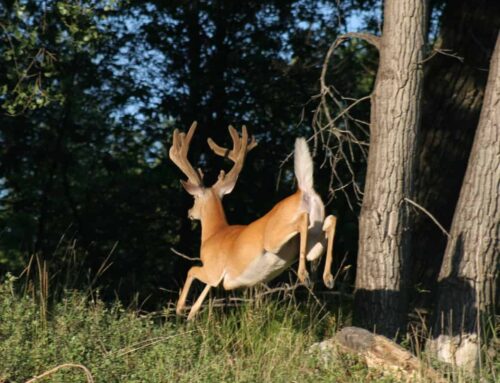One November Russ Van Zoeren hunted a public tract in Kansas for a week. For the first five days, the temperature was in the 70s, and the deer movement was predictably slow. But then one night, storms and a cold front crashed in. The mercury plummeted into the 30s, and a northwest wind shook the trees. Next morning at 8:15, a buck prowled out of the long, dense cedar thicket that Russ had been watching all week. The deer ripped a scrape and walked, grunting, beneath Russ’ stand. His arrow was true.
At just under 200 pounds dressed, the animal was on the light side for a mature Kansas buck. But there was nothing light about that rack, which grossed 238 6/8.
Two takeaways from Russ’ hunt: One, the day after a cold front whips through an area where it has been warm is a great time to hunt. Two, and more to the point here, researchers have found a direct correlation between heavy cover and rutting buck movement.
For several years whitetail researcher Bryan Kinkel monitored the hunting on several properties in western Tennessee. His records revealed that 95% of the 3.5-year-old and older bucks that were shot on these lands were killed within 100 yards of a well-defined sanctuary, such as a pine stand, brushy clear-cut or cedar thicket similar to the one where Russ killed his 230-inch Kansas monster.
You can never go wrong setting up downwind and tight to thick, linear evergreen cover. Now, three more great stand sites for November.
Staging Clearing
Look for a small clearing back in the woods 50 to 100 yards off a field of alfalfa, beans or clover. It might be an old log landing, strip of abandoned logging road, grassy glade…you get the idea. Slip in and set a tree stand on the downwind edge of the opening, and plan to hunt it in the mornings.
When the rut is coming on, some deer move off the fields at first light and gather in these clearings, where they feel safe and hidden, to posture and sniff each other before heading deeper into the woods to a bedding sanctuary.
A few years ago I hunted such a stand on the edge of an overgrown log road 70 yards off an alfalfa field in Montana. At sunrise I glassed out into the field and saw 10 deer coming my way. Five bucks arrived 20 minutes later and started pushing does around my stand, sparring and grunting like market hogs. Finally I was able to draw and smoke a big-bodied 10-pointer. It was one of the best mornings I can remember, and that is when a staging clearing became one of my favorite rut sets.
Elevated Ridge
One October day Brent Irelan’s buddy missed a huge buck on a ridge that overlooked a soybean field 80 yards below. Bummed, the guy pulled his stand and moved to a new location. But Brent figured the giant was still around, so he hung a stand in a fresh spot on the ridge.
Brent let the area rest for a few days, then climbed into the stand on November 6. A stick cracked behind; the Indiana bowhunter turned to see the massive buck, a double drop-tine titan! Brent’s arrow was on mark. The rack scored 199 non-typical.
There is no better spot for your stand than on an elevated ridge near a field of beans or corn. A hardwood ridge is staging area near the feed and a hub of buck traffic. Both local and vagabond bucks will cruise the hill, rubbing, scraping and sniffing out does. Much of this activity will occur at night, but some big deer start to move on the ridge earlier in the evenings, and linger after sunup. Set a stand on an edge of the ridge where the access and predominant wind are best.
Creek Bottom
A couple years ago, Paul McGregor started getting pictures of a huge buck on the Ohio farm he hunts. “Of 10 cameras scattered around the farm, I was getting pictures of him on only 3, and they were down in a thick, nasty creek bottom,” he said.
Paul did a ground scout and hung a stand near a shallow crossing with lots of fresh tracks. On November 9, he snuck into the stand. “By 10:45 a.m. I hadn’t seen a single deer,” he said. “At 11:15 the woods exploded.”
The giant chased a doe across the nearest ridge, running as hard as he could. “The doe made a hard cut right, and the buck plowed into her!” Paul recalls. Both deer lost their feet and slid down toward the creek. They jumped up and the doe leaped the creek. Paul drew his bow as the buck plowed across the water after her.
The deer paused for a split-second at 32 yards, and Paul fired. “I had the deer green scored by an official at 186 6/8 inches,” he says.
One of the best stand sites for the rut, is a strategic river or creek crossing rimmed with thick woods and cover. If a waterway flows through the woods you hunt, it will in some way dictate and funnel much of the deer movement through the area. Walk the creek or river banks and scout for natural crossings pocked with fresh tracks in the mud or sand. Hang a couple of stands on hot-looking crossings and you’ll see deer.








